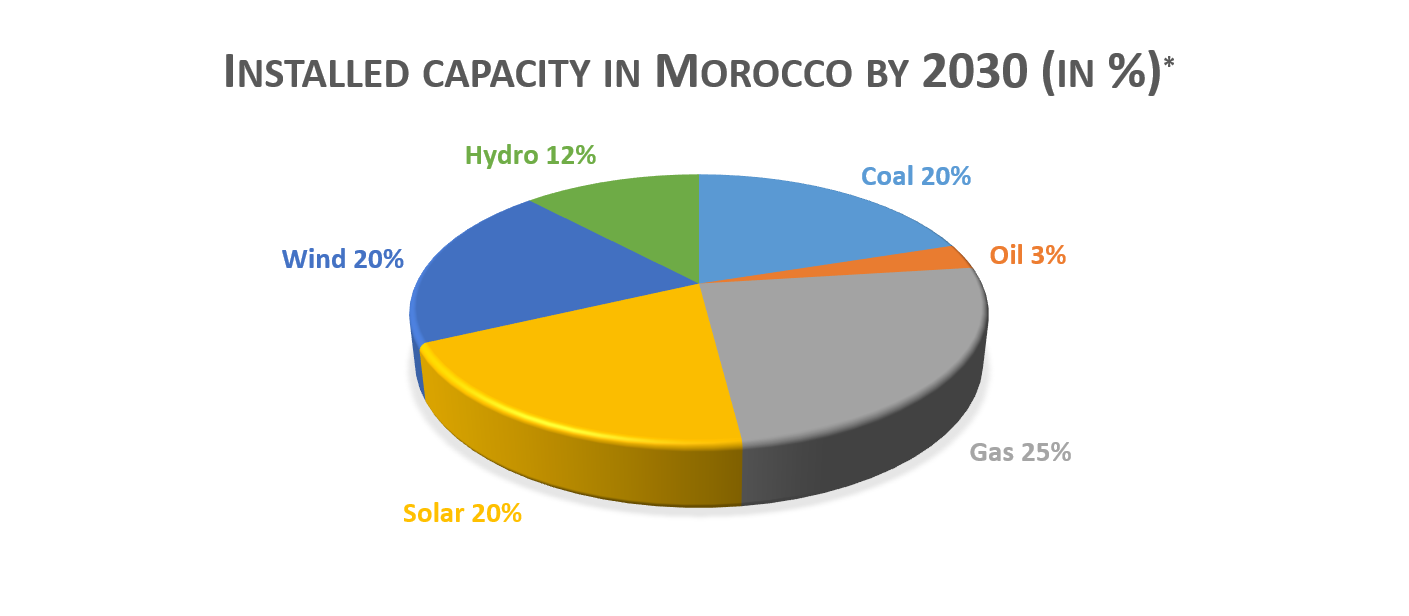By UMV
Climate is changing to the worst over the years owing to many factors including human activities1. Unlike previous decades, Earth is receiving now special attention of all actors believing in the necessity of making it a better place for future generations. Nevertheless, if the actual human behavior remains unchanged, it will affect badly the future of our planet. To fight against the greenhouse effect, humanity dependence on fossil fuels needs to be reduced and comply with the mandatory decrease of carbon emission in the atmosphere as imposed by the Paris agreements2. Different countries are now paying more and more attention to renewable energy (RE). Thanks to the strategic and geographic location of Morocco “at the heart of an energy hub (connection with the Spanish network through two 400V/700MW electric lines)”3, Morocco has a huge potential in renewable energy resources, and favorable conditions, particularly for wind and solar energy4. As part of its strategy towards the use of RE, to meet CO2 reduction targets and the international agreements, Morocco has been intensively investing in REs (a potential of 2600 kWh/m²/year) 3and in sustainable development with its universities and industries, starting from education to actions, and launching solar energy related projects, and giving priority to projects in this field, and building solar energy plants4. With its strategic position and policy, Morocco trade plays a potential market for the EU investors of PV systems and a good example for African countries. Thanks to its unique and principle geographic features and its involvement in European funding projects, Morocco targets reaching 42% installed RE capacity by 2020 and 52% by 2030, respectively (see graphs below).


*Calculations based on ONEE (National Office of Electricity and Water) and MEMEE (Ministry of Energy, Mines, Water and Environment) data.
University of Mohammed V in Rabat (UM5R), has shown a great interest in, and has impacted, the field of REs in Morocco, as a leader in research and development (R&D) and a key partner of several REs related projects, especially H2020 projects with consortiums from the European Union5,6,7,8. Photovoltaic technology, the main branch of solar energy, with its economic, environmental and ecological benefits, is one of the main technologies investigated through the projects at the UM5R. The photovoltaic (PV) panel does not release CO2 during its operation, it is silent, and it does not cause any environmental disturbance. The panels are recyclable9,10, with a doubly green cycle. As an academic institution, the university gives an excellent opportunity for students to discover and better understand the impacts, the causes and the solutions to mitigate the effects of global warming through different courses, training and workshops. In term of R&D projects at UM5R, different solar cell structures are studied, and various methods of material synthesis are used to prepare the main active layer in the PV solar cell, which is responsible for the conversion of sunlight into electricity, as well as other transparent conductive oxides used in the solar cell structure. This will improve the students and young researchers’ knowledge, therefore, become more environmentally responsible for brighter and cleaner future for them and the next generations. The REs research activities help enhance the research portfolio of the university.
The key elements of the PV system efficiency are solar panels, power electronics and data management. To work towards the main goals of the SUPER-PV project within the project’s consortium, UM5R, together with the Moroccan partners including MAScIR and MASEN, will be carrying tests in real climate conditions of innovative solar panels and power electronics and the related data management. UM5R focuses its activity, within the SUPER-PV project, on inverters and data management. Different parameters enter into play in the performance of the PV panels, including the solar irradiance and the panel temperature. In the frame work of the SUPER-PV project, with the innovator partners of power electronics PE (EOLANE, IREC, COSYLLAB, PROTECH), we will be able to study innovative inverters in real climate conditions and test modules performance, which will be installed on the roof top of the faculty of Sciences, UM5R, targeting a signification LCOE reduction.
1. [Global Climate Change: Evidence. NASA Global Climate Change and Global Warming: Vital Signs of the Planet. June 15, 2008. Accessed January 14, 2015] http://climate.nasa.gov/evidence/
2. ec.europa.eu
3. www.invest.gov.ma
4. [World Future Council, 2015, Anna Leidreiter, FilippoBoselli, 100% renewable energy: boosting development in Morocco]
5. [UROSUNMED project funded from the European Union’s Seventh Programme for research, technological development and demonstration under grant agreement No 608593]
6. Erasmus+ Medsol project
7. INFINITE CELL project, H2020-MSCA-RISE-2017, under grant agreement N° 777968
8. SUPER PV project funded from the European Union’s Horizon 2020 research and innovation programme under grant agreement N° 792245
9. http://www.sunelis.com
10. http://www.acqualys.fr

